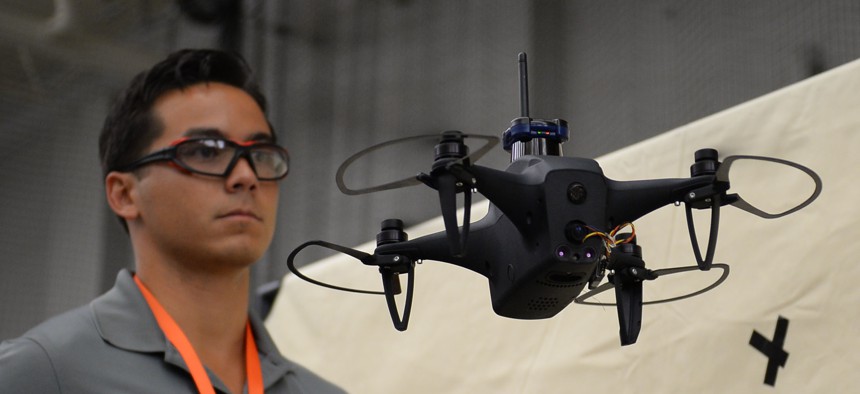
Brandon Tseng commands an autonomous drone during the ThunderDrone Tech Expo at SOFWERX in Tampa, Fla., in September. USAF / Master Sgt. Barry Loo
The Pentagon Is Losing the Innovation Battle. Here's How to Turn It Around
Four steps that will help better harness American innovation.
The United States military is losing the innovation battle. This is not hyperbole. Ellen Lord, defense undersecretary for acquisition and sustainment, made this point last December. In testimony before the Senate Armed Services Committee, she said, “The current pace at which we develop advanced capability is being eclipsed by those nations that pose the greatest threat to our security, seriously eroding our measure of overmatch.”
The Pentagon began to respond to this challenge in 2015, following the game plan of the intelligence community and planting a stake in Silicon Valley. After all, the thinking went, Silicon Valley has by far the world’s largest concentration of tech firms supported by private equity and venture investors; and the military would close the innovation gap by sitting at the same table as the investors funding future global-technology giants. DIUx later opened outposts in Boston and Austin.
But if the U.S. military wants to maintain its technological edge against potential adversaries, the armed forces must do better to reach beyond Silicon Valley, which is only a very small slice of the innovation pie.
Of today’s 5,000 fastest-growing companies in the United States, just 6.5 percent have received venture backing, according to Inc. magazine. Less than one percent — 37 — of these fast-growing firms are based in Silicon Valley, far fewer than, for example, the 110 companies based in Phoenix and the 187 in Dallas.
In other words, these companies, many of which are developing cutting-edge technology that could drive new lethal (and lifesaving) capabilities for U.S. warfighters, are being largely ignored by the U.S military.
Innovation is more distributed than any time in history. To keep the U.S. military ahead of its adversaries, the Pentagon needs to improve how it harvests ideas from America’s growing entrepreneur class. Here are four steps to take.
First, the Pentagon needs to expand its focus beyond Silicon Valley, looking for innovative firms wherever they are. In the technology sector, there is significant growth in places such as Orlando, Portland, and Raleigh-Durham.
Next, the Pentagon needs to expand its use of Other Transactional Authority contracting mechanisms. One of the biggest barriers to reaching small and innovative companies is the government contracting process. We can’t ask these small firms to become experts in a process that is not cheap, easy or fast. But a contract let through an OTA agreement sidesteps the traditionally lethargic government contracting process, enabling technology companies to rapidly develop prototypes for assessment by the military services. By offering a path through the government “valley of death,” OTAs could lure hundreds of companies around the country.
Third, where possible, the Pentagon must use follow-on authority. This allows the technology to go from prototype to limited production for up to two years while the government moves the program to a more traditional contract. This permits the entrepreneur to get started immediately, instead of waiting 12 to 18 months for the next contract.
Finally, we need to get more companies involved in Pentagon incubators like Sofwerx in Tampa and Afwerx in Las Vegas. These incubators help get small and medium-sized firms involved in solving the military’s most pressing problems.
In small pockets of the Pentagon’s sprawling technology establishment, these approaches have already led to meaningful innovation that will soon be in the hands of the military for testing and evaluation.
One example is Canton, Ohio-based American Bionics. Using technology developed at Johns Hopkins University for prosthetics, the company is working on an interface that gives warfighters the ability to send and receive signals from machines, including armaments, from hundreds of feet away. The company is readying a prototype for assessment. If successful, this technology could revolutionize the soldier-weapon interface.
The search for technological advantage has huge implications. The Center for New American Security has warned that the loss of technological dominance would have serious strategic consequences. “The erosion of U.S. military-technical advantages increases military risk, weakens the deterrent value of traditional capabilities, and undermines the DoD’s ability to generate nuanced military options to address the growing range of policy contingencies faced by the nation,” the group said in a December 2016 report.
If the U.S. military is to remain paramount, we need to cast a wide net to find firms with innovative technologies and attract them with contracting vehicles that are practical and streamlined. Only then can we ensure our military maintains the technological edge we have come to expect.



